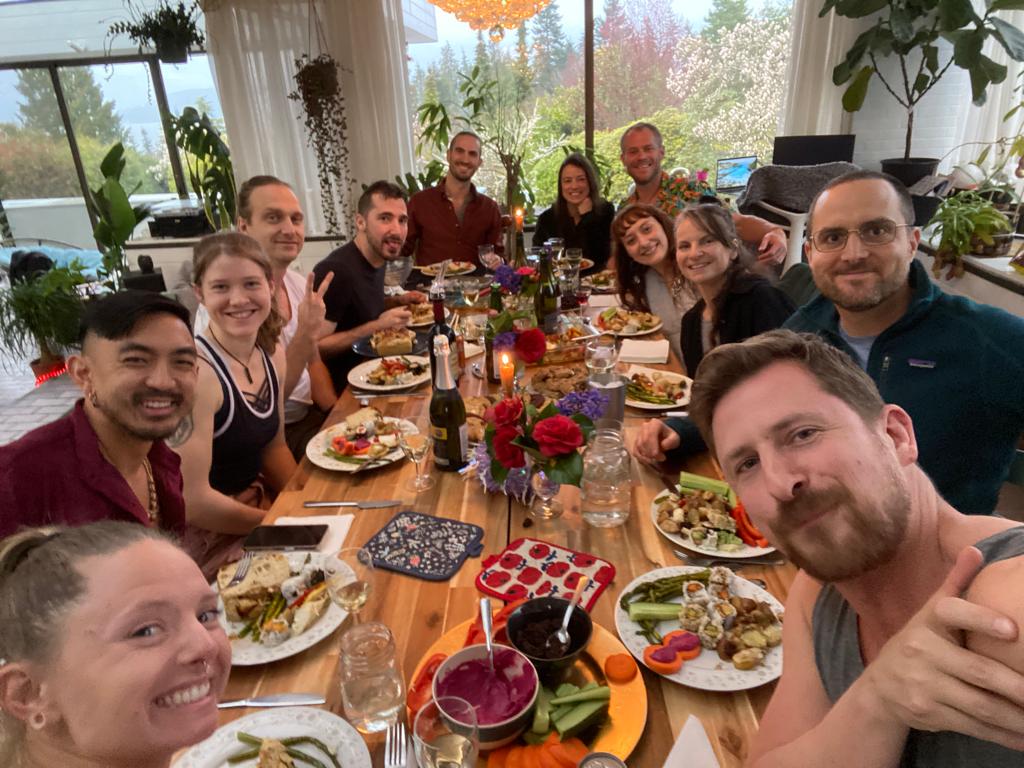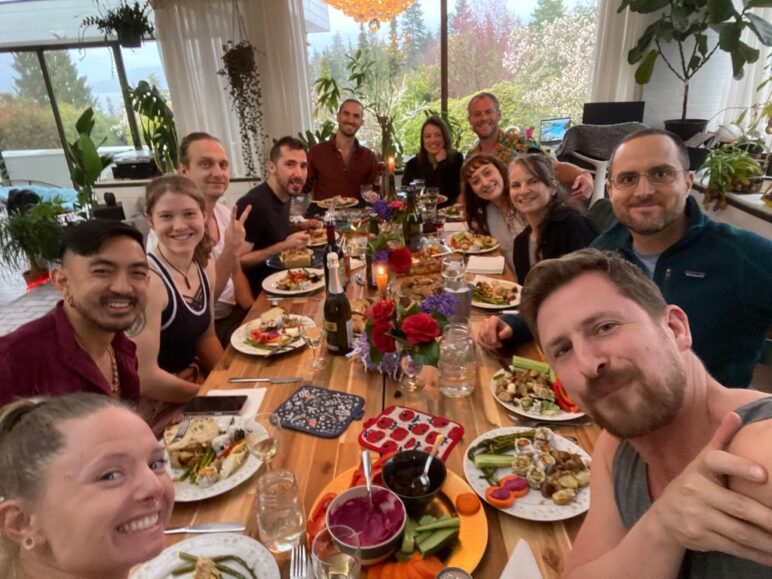In 2018, University of Victoria student Emma Edwards and her six roommates were evicted from their Saanich home. Their offense? Seven of them were living together under one roof, and the local government had a legal limit of four unrelated people per house. This house had seven bedrooms and plenty of space, but the law was the law. Saanich mayor Fred Haynes explained the move at the time, saying that “Neighborhoods are concerned about the impacts on the qualities of their lives.”
So these seven young women had to scramble and find new accommodations in a municipality with a minuscule 1.6 percent rental vacancy rate, in the middle of the school semester. This was, according to the mayor, all in the name of safeguarding quality of life in Saanich.
Since then, Saanich has increased the legal limit on roommates to six—progress, but too little too late for Ms. Edwards and her roommates.
Their story illustrates the need for British Columbia to follow the examples of Washington and Oregon and remove roommate caps provincewide (those states did so in 2021). As Sightline Institute has written previously, roommate caps are “tools that privileged people use to exclude from their neighborhoods people without much money, such as immigrants and students.”
In November 2022, on just his fourth day in office, BC premier David Eby removed rental restrictions in condominium buildings, opening up thousands of homes to renters. In the same spirit, British Columbia can remove roommate caps province-wide. This, too, could create or preserve homes for thousands by simply allowing the use of bedrooms currently sitting empty. And it would also put an end to the cruel, discriminatory practice of evicting people just because they want to share a big house with roommates to whom they aren’t legally related. The Province advanced housing policy in late 2023, permitting fourplexes Province-wide, and up to 20-storeys near transit, making it possible to build a lot more bedrooms. Simply allowing people to make full use of existing bedrooms, then, should be a no-brainer.
Roommate caps discriminate against non-traditional households
Why did cities restrict occupancy to related people in the first place? The historical reason was a core goal of zoning: enshrining the nuclear family in law. The Bartholomew Plan, Vancouver’s very first land use plan from nearly a century ago, states in its introduction, “The retention of Vancouver as a city of single family homes has always been close to the heart of those engaged in the preparation of this plan.”
Banning diverse and unconventional households and setting aside vast swaths of land for conventionally defined nuclear families has long been a priority of North American land use policymakers. In 1976, in Gross Point, Michigan, for example, a rule against unrelated people living together was used to evict two gay men.
It is hardly different in British Columbia today. As in Saanich, neighbors can wield the complaint-driven process to target for eviction people like students, economically sharing a house. Same goes for a group with any characteristic that you (or your nosiest neighbor) might find objectionable. This selective enforcement of roommate caps facilitates discrimination not just based on family status, but also on whatever quality (race, age, gender, sexual orientation, political belief) any concerned neighbor might personally dislike.
Blame the landlords, evict the tenants
Policymakers have offered a wide range of rationales to justify roommate caps: safety, traffic, noise, moral uprightness, neighborhood character, the prevention of crowding, and the protection of tenants from slumlords. (See this 2013 Sightline article for a thorough debunking.)
Protecting vulnerable tenants from unscrupulous landlords who overcrowd their rentals may sound legitimate. But scratch the surface, and this stated concern often masks the customary gripes about parking or “neighborhood character.”
Cities can protect vulnerable tenants by enforcing existing safety rules on landlords, rather than by evicting unrelated people or preventing them from sharing a home in the first place. More broadly, governments can help safeguard tenants by expanding the supply of rentals and building social housing.
Crowding is a common concern, but most housing and building codes already have separate anti-crowding rules that limit the number of people—as opposed to the type of person—who can inhabit a given amount of floorspace in a home. Roommate caps are not really about crowding but about exercising social control over living arrangements.
Similarly, if the complaint is noise, then it is noise that should be regulated, not the kind of people who are living together.
Parking? Same goes: the need to manage parking might be a justifiable reason to regulate the number or use of cars, but it’s not a justifiable reason to limit the number of people sharing a house based on their legal relationship to each other.
Discriminating based on family status is illegal in British Columbia
While it’s qualitatively clear that roommate caps discriminate, it’s also likely that they violate anti-discrimination laws. British Columbia law prohibits municipalities from discriminating against the occupants of homes based on family status with occupancy restrictions based on blood relations.
The issue arose in a 1990s court case decided by the Supreme Court of British Columbia. For three years, a woman had been renting a basement suite from a couple in the Vancouver suburb of Delta. Had she been related to the owners, there would have been no problem. But after a written complaint signed by nine local residents about four basement suites in the area, the city moved to evict her. Delta’s policy was not to proactively look for illegal suites but to investigate and sometimes evict tenants whom neighbors complained about.
The case was taken on by the Tenants’ Right and Action Coalition. TRAC included evidence about the low vacancy rate in the area at the time (1.3 percent) compared to a healthy vacancy rate (around 4 percent). The Supreme Court of British Columbia ruled that the government had no authority to discriminate against tenants based on family status.
Other tenants facing eviction under roommate caps could rely on this precedent to fight attempted evictions in court. After years of work, uncertainty, and cost, they might win. But the better solution would be for the Province to step in and remove these discriminatory provisions before yet more tenants become victims of these subjectively targeted evictions.
Roommate caps in British Columbia
Roommate caps vary by municipality, but in general they prohibit more than five unrelated people from living together in one home. As shown in the table at the end of this article, British Columbia’s cities and towns define “family” in numerous ways and vary their allowed numbers of unrelated occupants.
Some of the rules are downright strange: in the University Endowment Lands, a wealthy enclave just west of Vancouver, there is an exception to the unrelated occupants cap for those who can afford live-in domestic servants.
British Columbia has 161 municipalities, and a review of all of them would doubtless reveal even more inconsistency and complexity. Meanwhile, major municipalities like Surrey and Victoria get along just fine without any roommate caps at all. If they can do it, why not every city in the province?
Ban empty homes, but require empty bedrooms?
Empty homes have generated a lot of moral outrage in British Columbia as housing prices have soared. It’s easy to understand why. To a person struggling tco make rent or with an outsized mortgage, an empty home sitting unused seems to mock their hardship. This is why Vancouver (2017), British Columbia (2018), and Canada (2022) have all enacted laws imposing extra taxes on owners who hold homes empty.
Governments are filling empty homes with one hand but emptying bedrooms with the other.

But even as politicians scramble to enact policies to fill empty homes, most BC municipalities effectively require empty bedrooms. Enforcing roommate caps in a society whose average family size has dropped precipitously since many of its homes were built means cities are preventing those homes from being fully utilized by non-traditional households.
Governments are filling empty homes with one hand but emptying bedrooms with the other.
And the numbers show that empty bedrooms are the bigger issue. Estimates of empty homes in Vancouver range from the 1,755 that paid the empty homes tax in 2020 to an unlikely high estimate of 25,495. Meanwhile, according to UBC sociologist Nathan Lauster, in the City of Vancouver there are probably about 459,994 empty bedrooms, or about one in five. Another estimate put that number at 800,000. For context, Sightline previously estimated that there were about 5 million empty bedrooms in Washington, Oregon, and Idaho combined.
Mandated empty bedrooms caused by roommate caps are an especially acute problem for Vancouver, because it has an unusually high fraction of houses with many bedrooms. In Vancouver in 2011, 12 percent of all housing units had five or more bedrooms—the most out of Canada’s biggest cities.
In a place like Vancouver, with its outsized number of gigantic houses, it’s especially illogical to require empty bedrooms while at the same time imposing financial penalties intended to keep homes full. And it’s also cruel to single out people in unconventional household arrangements and threaten them with eviction for making full use of large houses.
But this article is not about how we can or whether we should encourage all those empty bedrooms to be filled. The argument here is much narrower: cities should not require empty bedrooms. Not during a housing crisis, and probably not at all.
(Past) Time to legalize roommates
Where people want to live in large homes with many unrelated roommates, they should be allowed to do so. These large homes exist, so why not use them? As set out in an excellent profile on mansion life in The Tyee in 2015, and despite it being formally illegal, people in Vancouver have been finding community and affordable housing in mansions for at least a decade.
I first advocated for removing roommate caps as a member of Vancouver’s Renters’ Advisory Committee in 2017. Today, my conviction that these caps are wrong is more personal. I am currently living with eight roommates in a large, nine-bedroom home. It was empty until British Columbia enacted its empty homes tax, which was likely the impetus for the owner putting it on the market as a rental.
But under local law, it is illegal to fill all nine bedrooms unless everyone is legally related, which we are not. We are professionals, entrepreneurs, parents, immigrants, long-time locals, and members of the community. It is an 11,000-square-foot house on a 30,000-square-foot lot. The house easily has room for more than nine residents, but the arbitrary limit of five unrelated occupants not only discriminates against us, but also reduces housing options during a housing crisis.
Some of our neighbors may not love having renters in the area, as many of them likely bought their $15–30 million mansions to achieve a certain exclusivity and prestige. The law favors their preferences. Today in most of British Columbia, local governments are free to discriminate against unrelated renters and are most likely to do so when they get complaints from busybody neighbors.
But the question is: should someone’s distaste for having renters in their neighborhood prevail over people’s need for shelter? The province’s southern neighbors, Washington and Oregon, don’t think so. Amid a dire housing shortage, British Columbia should consider joining them.
Appendix
Table 1: Roommate caps for selected BC municipalities
| City | Maximum unrelated people in one unit | Permitted number of boarders or lodgers | Definition of “family” |
| Anmore | 5 | 2 | (a) 1 person alone, or 2 or more persons related by blood, marriage, adoption, common law or foster parenthood sharing one dwelling unit; or
(b) not more than 3 unrelated persons sharing one dwelling unit |
| Burnaby | None | 2 | 1 or more people living together in a dwelling as a single non-profit household |
| Kelowna | 5, plus a nanny or housekeeper | N/A | Defines “household,” instead of “family,” as:
a) a person; or (b) 2 or more persons related by blood, marriage, or adoption; or associated through foster care, all living together in one dwelling unit as a single household using common cooking facilities; or (c) a group of not more than 5 persons, including boarders, who are not related by blood, marriage, or adoption, or associated through foster care, all living together in one dwelling unit as a single household using common cooking facilities; or (d) a combination of (b) and (c), provided that the combined total does not include more than 3 persons unrelated by blood, marriage, or adoption or associated through foster care; all living together in one dwelling unit as a single household using common cooking facilities; (e) in addition, a household may also include up to one housekeeper or nanny. |
| Saanich | 6 | 2, but the total number of unrelated occupants cannot exceed 6 | one or more individuals who by reason of marriage, heredity, adoption, or choice live as a household; provided that the number of persons unrelated by blood or marriage shall not exceed 6; excludes boarders, daycare children, or groups of persons forming a monastery, seminary, convent, or similar religious group |
| Surrey | None | 2 | 1 or more persons occupying a dwelling unit and living as a single non-profit housekeeping unit |
| University Endowment Lands | 5, unless providing full-time, live-in domestic services | 2 | 1 or more individuals living as a household and in the case of persons unrelated by blood, marriage, or other law, shall not exceed 3 in number |
| Vancouver | 5 | 2 | Either:
(a) 1 or more individuals all related to one another by blood, marriage, or adoption; or (b) a maximum of 3 unrelated individuals living together as a household |
| Victoria | None | n/a | 1 person or a group of persons who through marriage, blood relationship, or other circumstances normally live together |











Neil Vokey
While the municipal occupant caps certainly present a risk tenants in roommate situations (just as municipal codes threaten tenants in “illegal” suites), a far more significant impediment for roommates’ rights in British Columbia is the lack of protections within the Residential Tenancy Act. Currently the law allows the landlord to renegotiate a new lease every time a co-tenant/roommate moves in and out of a suite. A new lease means skirting around rent control laws, potentially causing massive rent increases and jeopardizing otherwise stable households with economic displacement. It’s true that some landlords may agree to a new lease without jacking up the rent – but for tenants it’s a roll of the dice. As a result, many roommates in British Columbia choose to not add their names to a lease and thus are not protected by any rights that all tenants should enjoy.
I am surprised such a lengthy article about “legalizing roommates” entirely ignores the provincial laws that so blatantly threaten the economic security of all but the most affluent roommate/chosen family households. Perhaps the author’s personal experience in an affluent area with affluent roommates colours his analysis. I too have lived in multiple “overcrowded” roommate households. In all cases, tenants lived together out of economic necessity first – living in harmony was an added bonus. The question of changing the lease when roommates came and went was a much more serious existential question than whether or not a municipal bylaw officer might drop by.
Garey Jonson
Increasingly, I find it obscene for two to four people living in a huge eight, ten or more bedroom homes. Who deserves to live in such extreme conditions when many live on the street. The way will change.